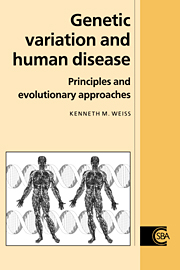Book contents
- Frontmatter
- Contents
- Frontispiece
- Preface: what is this book all about?
- Notational conventions used in this book
- List of abbreviations
- Part I Genes and their expression
- Part II Introduction to genetic epidemiology: inference from observational data
- Part III Evolution: the time dimension in populations
- Part IV Modification of the inherited genotype: the time dimension in individuals
- 12 Phenotype amplification by the environment
- 13 Infectious disease: the response to biological challenge
- 14 Variation within the inherited genotype
- 15 Cancer and aging: a microcosm of evolution during life
- Afterwords: towards a unified general model
- References
- Index
12 - Phenotype amplification by the environment
from Part IV - Modification of the inherited genotype: the time dimension in individuals
Published online by Cambridge University Press: 05 June 2012
- Frontmatter
- Contents
- Frontispiece
- Preface: what is this book all about?
- Notational conventions used in this book
- List of abbreviations
- Part I Genes and their expression
- Part II Introduction to genetic epidemiology: inference from observational data
- Part III Evolution: the time dimension in populations
- Part IV Modification of the inherited genotype: the time dimension in individuals
- 12 Phenotype amplification by the environment
- 13 Infectious disease: the response to biological challenge
- 14 Variation within the inherited genotype
- 15 Cancer and aging: a microcosm of evolution during life
- Afterwords: towards a unified general model
- References
- Index
Summary
Diverse forms of allometry
Allometry is a term that refers to the quantitative scaling relationships between biological traits, such as between metabolic rate and body size among species. The term can be extended to refer to systematic dose – response relationships between genes, environments, and phenotypes – that is, to risk factors (covariates or concomitants) that determine the penetrance (G → P) function.
A challenge to genetic inference is to identify those situations that magnify or clarify the phenotypic differences among genotypes. Exposure to environmental risk factors often leads to phenotype amplification; that is, to phenotypes that become increasingly divergent, and easier to identify, with exposure dose and duration (or age). Other factors, however, may obscure the effects of different genotypes. We saw in Chapter 6 how to include unmeasured risk factors, such as the ‘environmental’ variance, in terms of their aggregate effect on phenotypic variance. This chapter is concerned with the effects of those risk factors that we can identify and measure on individuals.
We usually have no specific biological model for the dose–response relationships of such variables, and usually parameterize those relationships with general epidemiological models such as those given in Chapter 3.
The complex map from genotype to phenotype
The complexities and levels at which genetic and environmental factors can affect a subsequent outcome phenotype are illustrated schematically in Figure 12.1 for the case of CHD; for example, cholesterol is one component of the atherosclerotic plaques that may lead to clotting reactions producing heart attacks.
- Type
- Chapter
- Information
- Genetic Variation and Human DiseasePrinciples and Evolutionary Approaches, pp. 229 - 252Publisher: Cambridge University PressPrint publication year: 1993
- 1
- Cited by



